Optus Company: Analysis of Inventory Accounting and Cost Management
VerifiedAdded on 2020/04/07
|7
|1518
|40
Report
AI Summary
This report provides an in-depth analysis of Optus Pty Ltd's inventory accounting and cost management practices, focusing on the principles outlined in AASB 101 and 102. The study evaluates Optus's use of the weighted average method for inventory valuation, the perpetual inventory system, and the impact of these methods on the company's financial statements. It examines how Optus complies with regulatory norms, including disclosures in its annual reports. The report also discusses the implications of different costing methods, such as FIFO and LIFO, on inventory valuation, cost of goods sold, and profitability ratios. The analysis covers key aspects like work in progress, trade receivables and payables, and the recognition of potential contract losses. The report concludes that Optus adheres to all regulatory standards concerning inventory accounting and cost management, providing appropriate disclosures within its financial statements.
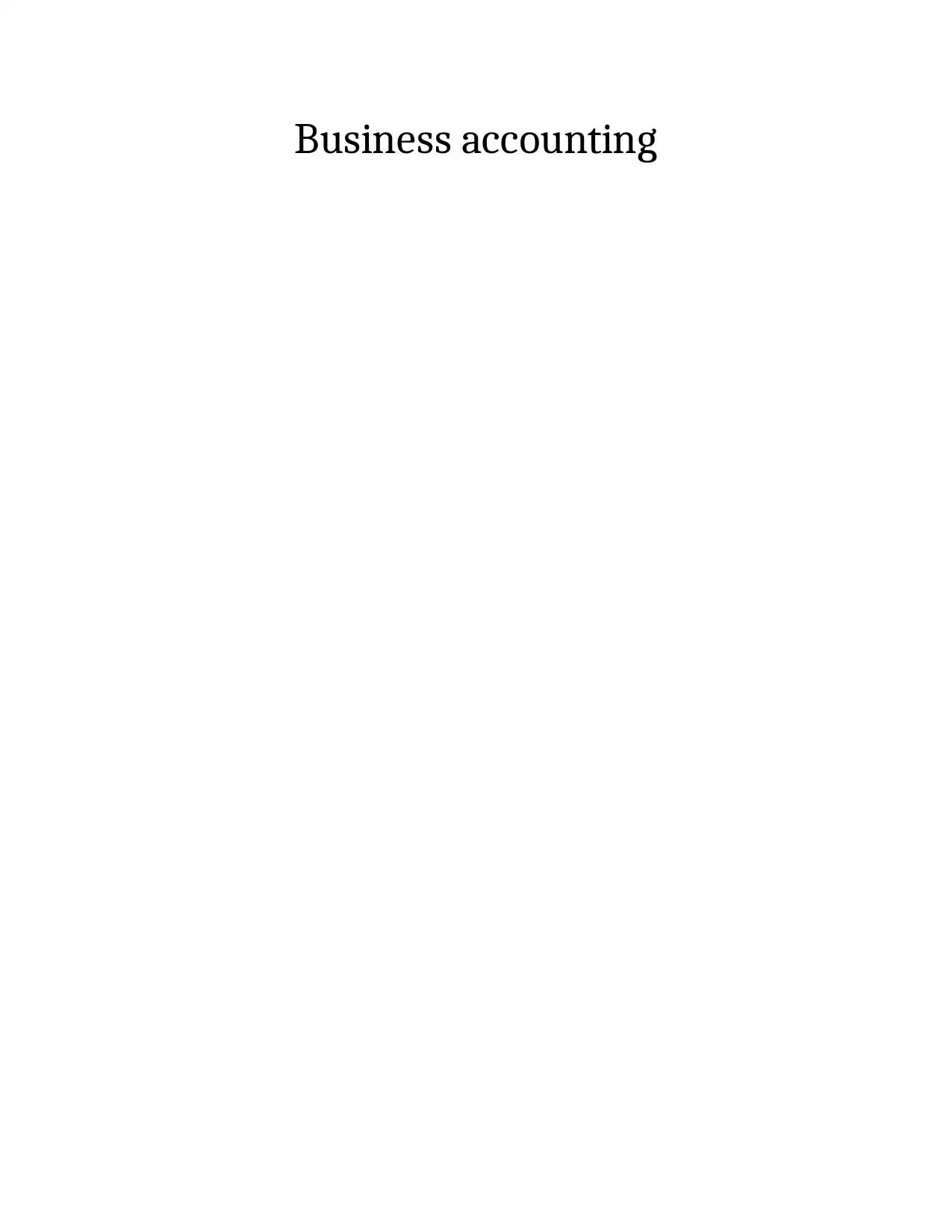
Business accounting
Paraphrase This Document
Need a fresh take? Get an instant paraphrase of this document with our AI Paraphraser
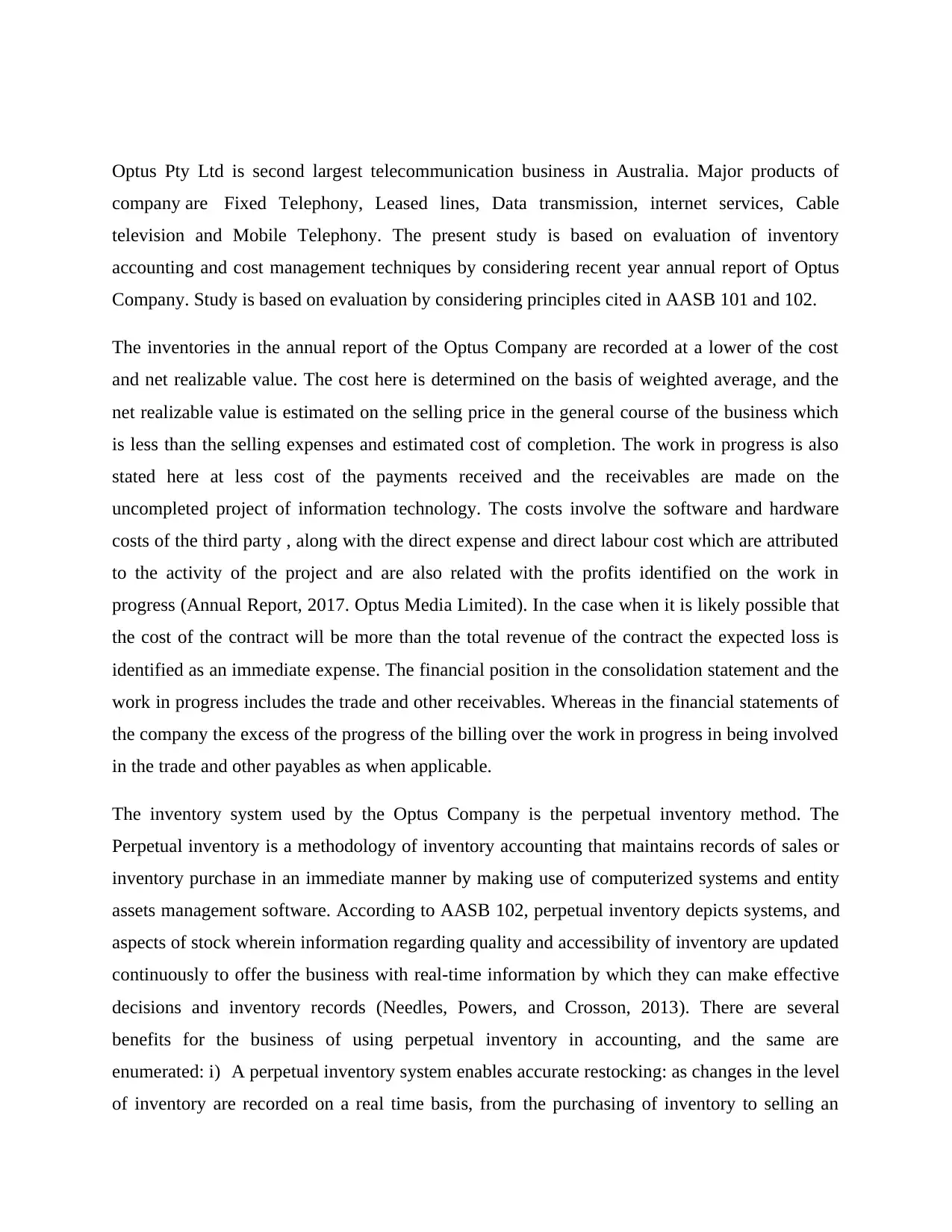
Optus Pty Ltd is second largest telecommunication business in Australia. Major products of
company are Fixed Telephony, Leased lines, Data transmission, internet services, Cable
television and Mobile Telephony. The present study is based on evaluation of inventory
accounting and cost management techniques by considering recent year annual report of Optus
Company. Study is based on evaluation by considering principles cited in AASB 101 and 102.
The inventories in the annual report of the Optus Company are recorded at a lower of the cost
and net realizable value. The cost here is determined on the basis of weighted average, and the
net realizable value is estimated on the selling price in the general course of the business which
is less than the selling expenses and estimated cost of completion. The work in progress is also
stated here at less cost of the payments received and the receivables are made on the
uncompleted project of information technology. The costs involve the software and hardware
costs of the third party , along with the direct expense and direct labour cost which are attributed
to the activity of the project and are also related with the profits identified on the work in
progress (Annual Report, 2017. Optus Media Limited). In the case when it is likely possible that
the cost of the contract will be more than the total revenue of the contract the expected loss is
identified as an immediate expense. The financial position in the consolidation statement and the
work in progress includes the trade and other receivables. Whereas in the financial statements of
the company the excess of the progress of the billing over the work in progress in being involved
in the trade and other payables as when applicable.
The inventory system used by the Optus Company is the perpetual inventory method. The
Perpetual inventory is a methodology of inventory accounting that maintains records of sales or
inventory purchase in an immediate manner by making use of computerized systems and entity
assets management software. According to AASB 102, perpetual inventory depicts systems, and
aspects of stock wherein information regarding quality and accessibility of inventory are updated
continuously to offer the business with real-time information by which they can make effective
decisions and inventory records (Needles, Powers, and Crosson, 2013). There are several
benefits for the business of using perpetual inventory in accounting, and the same are
enumerated: i) A perpetual inventory system enables accurate restocking: as changes in the level
of inventory are recorded on a real time basis, from the purchasing of inventory to selling an
company are Fixed Telephony, Leased lines, Data transmission, internet services, Cable
television and Mobile Telephony. The present study is based on evaluation of inventory
accounting and cost management techniques by considering recent year annual report of Optus
Company. Study is based on evaluation by considering principles cited in AASB 101 and 102.
The inventories in the annual report of the Optus Company are recorded at a lower of the cost
and net realizable value. The cost here is determined on the basis of weighted average, and the
net realizable value is estimated on the selling price in the general course of the business which
is less than the selling expenses and estimated cost of completion. The work in progress is also
stated here at less cost of the payments received and the receivables are made on the
uncompleted project of information technology. The costs involve the software and hardware
costs of the third party , along with the direct expense and direct labour cost which are attributed
to the activity of the project and are also related with the profits identified on the work in
progress (Annual Report, 2017. Optus Media Limited). In the case when it is likely possible that
the cost of the contract will be more than the total revenue of the contract the expected loss is
identified as an immediate expense. The financial position in the consolidation statement and the
work in progress includes the trade and other receivables. Whereas in the financial statements of
the company the excess of the progress of the billing over the work in progress in being involved
in the trade and other payables as when applicable.
The inventory system used by the Optus Company is the perpetual inventory method. The
Perpetual inventory is a methodology of inventory accounting that maintains records of sales or
inventory purchase in an immediate manner by making use of computerized systems and entity
assets management software. According to AASB 102, perpetual inventory depicts systems, and
aspects of stock wherein information regarding quality and accessibility of inventory are updated
continuously to offer the business with real-time information by which they can make effective
decisions and inventory records (Needles, Powers, and Crosson, 2013). There are several
benefits for the business of using perpetual inventory in accounting, and the same are
enumerated: i) A perpetual inventory system enables accurate restocking: as changes in the level
of inventory are recorded on a real time basis, from the purchasing of inventory to selling an
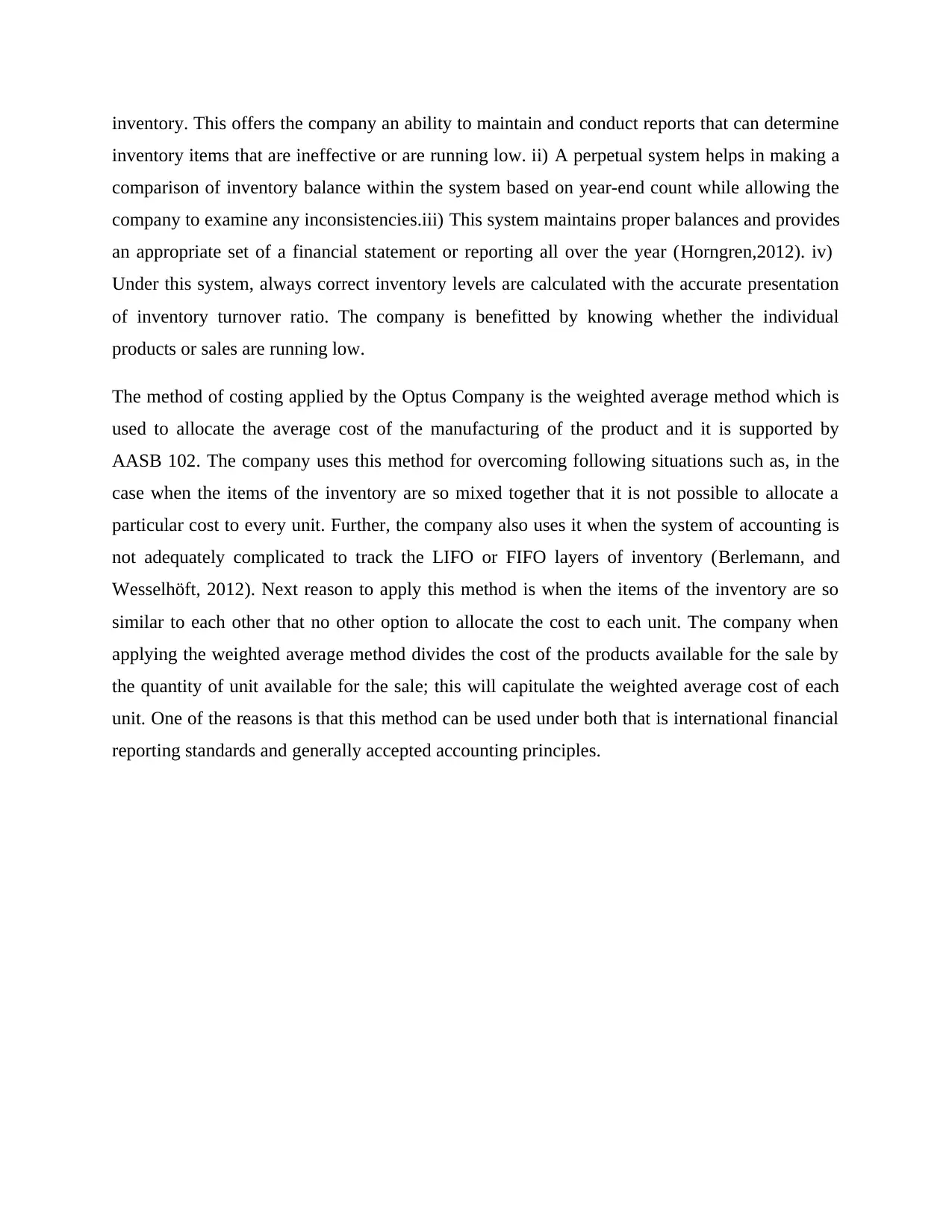
inventory. This offers the company an ability to maintain and conduct reports that can determine
inventory items that are ineffective or are running low. ii) A perpetual system helps in making a
comparison of inventory balance within the system based on year-end count while allowing the
company to examine any inconsistencies.iii) This system maintains proper balances and provides
an appropriate set of a financial statement or reporting all over the year (Horngren,2012). iv)
Under this system, always correct inventory levels are calculated with the accurate presentation
of inventory turnover ratio. The company is benefitted by knowing whether the individual
products or sales are running low.
The method of costing applied by the Optus Company is the weighted average method which is
used to allocate the average cost of the manufacturing of the product and it is supported by
AASB 102. The company uses this method for overcoming following situations such as, in the
case when the items of the inventory are so mixed together that it is not possible to allocate a
particular cost to every unit. Further, the company also uses it when the system of accounting is
not adequately complicated to track the LIFO or FIFO layers of inventory (Berlemann, and
Wesselhöft, 2012). Next reason to apply this method is when the items of the inventory are so
similar to each other that no other option to allocate the cost to each unit. The company when
applying the weighted average method divides the cost of the products available for the sale by
the quantity of unit available for the sale; this will capitulate the weighted average cost of each
unit. One of the reasons is that this method can be used under both that is international financial
reporting standards and generally accepted accounting principles.
inventory items that are ineffective or are running low. ii) A perpetual system helps in making a
comparison of inventory balance within the system based on year-end count while allowing the
company to examine any inconsistencies.iii) This system maintains proper balances and provides
an appropriate set of a financial statement or reporting all over the year (Horngren,2012). iv)
Under this system, always correct inventory levels are calculated with the accurate presentation
of inventory turnover ratio. The company is benefitted by knowing whether the individual
products or sales are running low.
The method of costing applied by the Optus Company is the weighted average method which is
used to allocate the average cost of the manufacturing of the product and it is supported by
AASB 102. The company uses this method for overcoming following situations such as, in the
case when the items of the inventory are so mixed together that it is not possible to allocate a
particular cost to every unit. Further, the company also uses it when the system of accounting is
not adequately complicated to track the LIFO or FIFO layers of inventory (Berlemann, and
Wesselhöft, 2012). Next reason to apply this method is when the items of the inventory are so
similar to each other that no other option to allocate the cost to each unit. The company when
applying the weighted average method divides the cost of the products available for the sale by
the quantity of unit available for the sale; this will capitulate the weighted average cost of each
unit. One of the reasons is that this method can be used under both that is international financial
reporting standards and generally accepted accounting principles.
⊘ This is a preview!⊘
Do you want full access?
Subscribe today to unlock all pages.

Trusted by 1+ million students worldwide
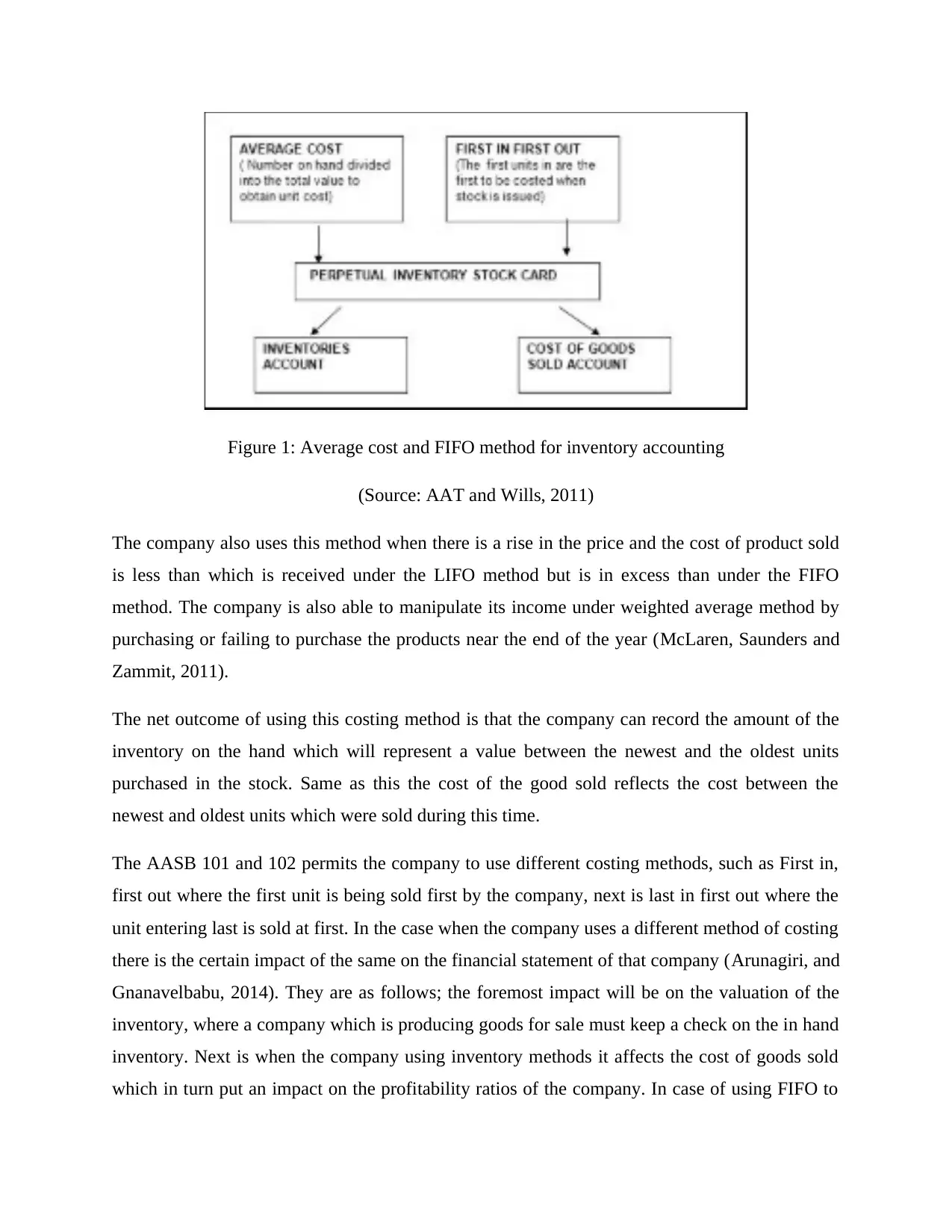
Figure 1: Average cost and FIFO method for inventory accounting
(Source: AAT and Wills, 2011)
The company also uses this method when there is a rise in the price and the cost of product sold
is less than which is received under the LIFO method but is in excess than under the FIFO
method. The company is also able to manipulate its income under weighted average method by
purchasing or failing to purchase the products near the end of the year (McLaren, Saunders and
Zammit, 2011).
The net outcome of using this costing method is that the company can record the amount of the
inventory on the hand which will represent a value between the newest and the oldest units
purchased in the stock. Same as this the cost of the good sold reflects the cost between the
newest and oldest units which were sold during this time.
The AASB 101 and 102 permits the company to use different costing methods, such as First in,
first out where the first unit is being sold first by the company, next is last in first out where the
unit entering last is sold at first. In the case when the company uses a different method of costing
there is the certain impact of the same on the financial statement of that company (Arunagiri, and
Gnanavelbabu, 2014). They are as follows; the foremost impact will be on the valuation of the
inventory, where a company which is producing goods for sale must keep a check on the in hand
inventory. Next is when the company using inventory methods it affects the cost of goods sold
which in turn put an impact on the profitability ratios of the company. In case of using FIFO to
(Source: AAT and Wills, 2011)
The company also uses this method when there is a rise in the price and the cost of product sold
is less than which is received under the LIFO method but is in excess than under the FIFO
method. The company is also able to manipulate its income under weighted average method by
purchasing or failing to purchase the products near the end of the year (McLaren, Saunders and
Zammit, 2011).
The net outcome of using this costing method is that the company can record the amount of the
inventory on the hand which will represent a value between the newest and the oldest units
purchased in the stock. Same as this the cost of the good sold reflects the cost between the
newest and oldest units which were sold during this time.
The AASB 101 and 102 permits the company to use different costing methods, such as First in,
first out where the first unit is being sold first by the company, next is last in first out where the
unit entering last is sold at first. In the case when the company uses a different method of costing
there is the certain impact of the same on the financial statement of that company (Arunagiri, and
Gnanavelbabu, 2014). They are as follows; the foremost impact will be on the valuation of the
inventory, where a company which is producing goods for sale must keep a check on the in hand
inventory. Next is when the company using inventory methods it affects the cost of goods sold
which in turn put an impact on the profitability ratios of the company. In case of using FIFO to
Paraphrase This Document
Need a fresh take? Get an instant paraphrase of this document with our AI Paraphraser
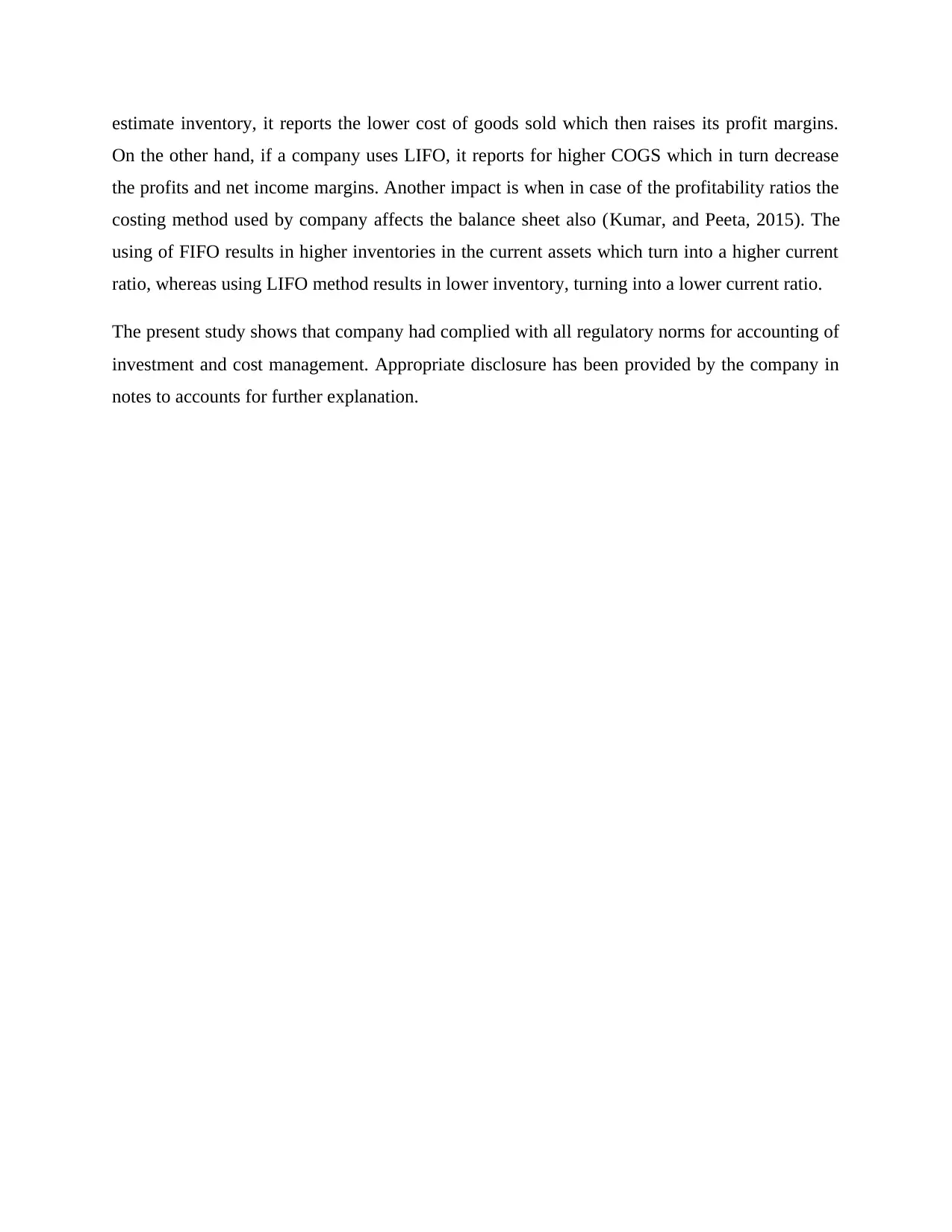
estimate inventory, it reports the lower cost of goods sold which then raises its profit margins.
On the other hand, if a company uses LIFO, it reports for higher COGS which in turn decrease
the profits and net income margins. Another impact is when in case of the profitability ratios the
costing method used by company affects the balance sheet also (Kumar, and Peeta, 2015). The
using of FIFO results in higher inventories in the current assets which turn into a higher current
ratio, whereas using LIFO method results in lower inventory, turning into a lower current ratio.
The present study shows that company had complied with all regulatory norms for accounting of
investment and cost management. Appropriate disclosure has been provided by the company in
notes to accounts for further explanation.
On the other hand, if a company uses LIFO, it reports for higher COGS which in turn decrease
the profits and net income margins. Another impact is when in case of the profitability ratios the
costing method used by company affects the balance sheet also (Kumar, and Peeta, 2015). The
using of FIFO results in higher inventories in the current assets which turn into a higher current
ratio, whereas using LIFO method results in lower inventory, turning into a lower current ratio.
The present study shows that company had complied with all regulatory norms for accounting of
investment and cost management. Appropriate disclosure has been provided by the company in
notes to accounts for further explanation.
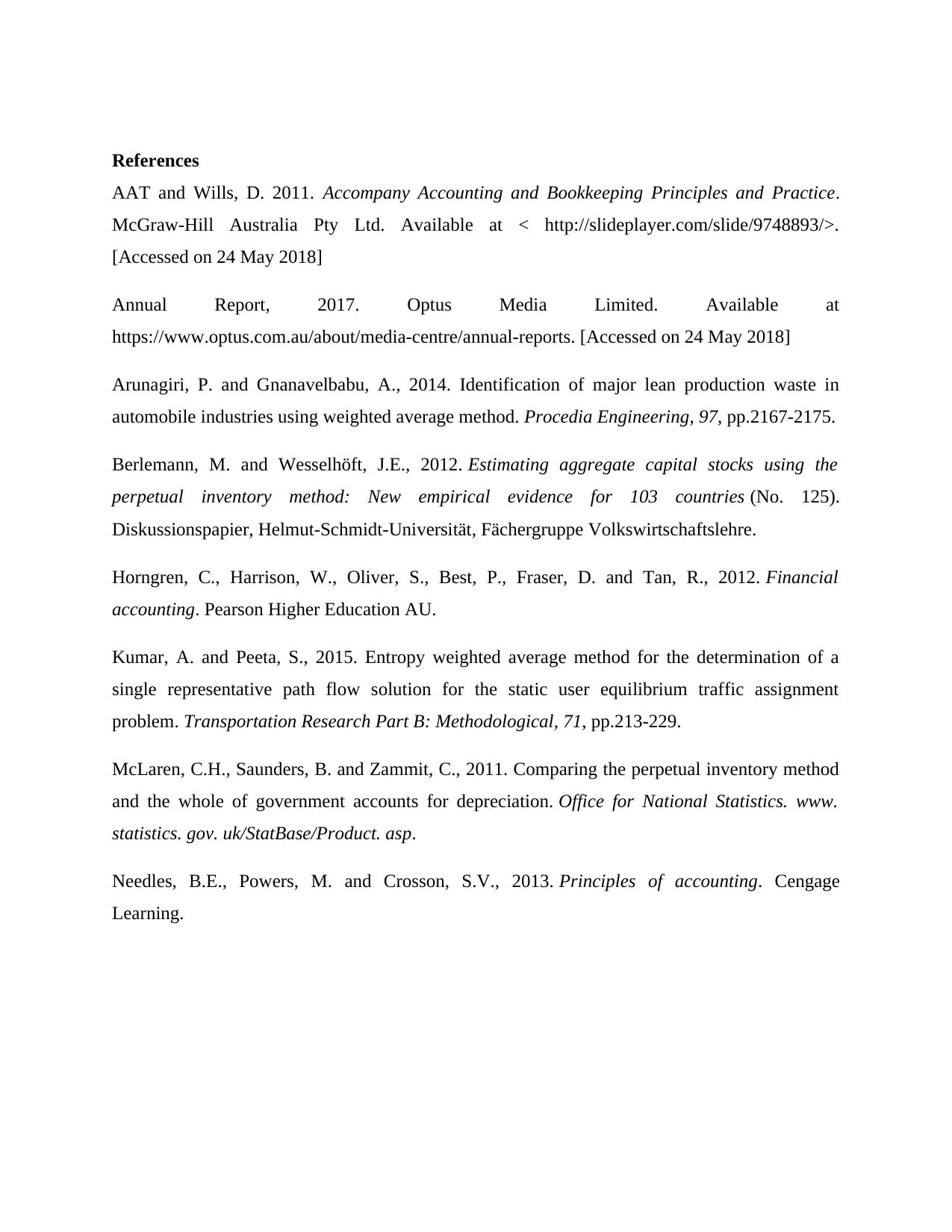
References
AAT and Wills, D. 2011. Accompany Accounting and Bookkeeping Principles and Practice.
McGraw-Hill Australia Pty Ltd. Available at < http://slideplayer.com/slide/9748893/>.
[Accessed on 24 May 2018]
Annual Report, 2017. Optus Media Limited. Available at
https://www.optus.com.au/about/media-centre/annual-reports. [Accessed on 24 May 2018]
Arunagiri, P. and Gnanavelbabu, A., 2014. Identification of major lean production waste in
automobile industries using weighted average method. Procedia Engineering, 97, pp.2167-2175.
Berlemann, M. and Wesselhöft, J.E., 2012. Estimating aggregate capital stocks using the
perpetual inventory method: New empirical evidence for 103 countries (No. 125).
Diskussionspapier, Helmut-Schmidt-Universität, Fächergruppe Volkswirtschaftslehre.
Horngren, C., Harrison, W., Oliver, S., Best, P., Fraser, D. and Tan, R., 2012. Financial
accounting. Pearson Higher Education AU.
Kumar, A. and Peeta, S., 2015. Entropy weighted average method for the determination of a
single representative path flow solution for the static user equilibrium traffic assignment
problem. Transportation Research Part B: Methodological, 71, pp.213-229.
McLaren, C.H., Saunders, B. and Zammit, C., 2011. Comparing the perpetual inventory method
and the whole of government accounts for depreciation. Office for National Statistics. www.
statistics. gov. uk/StatBase/Product. asp.
Needles, B.E., Powers, M. and Crosson, S.V., 2013. Principles of accounting. Cengage
Learning.
AAT and Wills, D. 2011. Accompany Accounting and Bookkeeping Principles and Practice.
McGraw-Hill Australia Pty Ltd. Available at < http://slideplayer.com/slide/9748893/>.
[Accessed on 24 May 2018]
Annual Report, 2017. Optus Media Limited. Available at
https://www.optus.com.au/about/media-centre/annual-reports. [Accessed on 24 May 2018]
Arunagiri, P. and Gnanavelbabu, A., 2014. Identification of major lean production waste in
automobile industries using weighted average method. Procedia Engineering, 97, pp.2167-2175.
Berlemann, M. and Wesselhöft, J.E., 2012. Estimating aggregate capital stocks using the
perpetual inventory method: New empirical evidence for 103 countries (No. 125).
Diskussionspapier, Helmut-Schmidt-Universität, Fächergruppe Volkswirtschaftslehre.
Horngren, C., Harrison, W., Oliver, S., Best, P., Fraser, D. and Tan, R., 2012. Financial
accounting. Pearson Higher Education AU.
Kumar, A. and Peeta, S., 2015. Entropy weighted average method for the determination of a
single representative path flow solution for the static user equilibrium traffic assignment
problem. Transportation Research Part B: Methodological, 71, pp.213-229.
McLaren, C.H., Saunders, B. and Zammit, C., 2011. Comparing the perpetual inventory method
and the whole of government accounts for depreciation. Office for National Statistics. www.
statistics. gov. uk/StatBase/Product. asp.
Needles, B.E., Powers, M. and Crosson, S.V., 2013. Principles of accounting. Cengage
Learning.
⊘ This is a preview!⊘
Do you want full access?
Subscribe today to unlock all pages.

Trusted by 1+ million students worldwide

1 out of 7
Related Documents
Your All-in-One AI-Powered Toolkit for Academic Success.
+13062052269
info@desklib.com
Available 24*7 on WhatsApp / Email
![[object Object]](/_next/static/media/star-bottom.7253800d.svg)
Unlock your academic potential
Copyright © 2020–2025 A2Z Services. All Rights Reserved. Developed and managed by ZUCOL.





